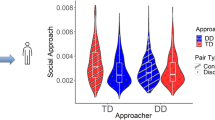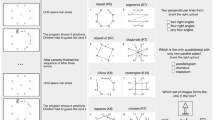Abstract
Distances between closest playmates were measured during free play in mentally retarded and normal grade school children. Unobtrusive observation techniques minimized interference and a spacious playground environment was chosen to avoid effects of confining walls on spatial behavior. Younger children (grades 1–3) kept closer distances than older children (grades 4–6), independent of clinical history or sex (p<.0001). Parallels are drawn with findings of previous observational studies in adults and non-human primates; two hypotheses, based on cognitive development and social disturbance, are proposed to explain the findings.
Similar content being viewed by others
References
Aiello, M.R., & Aiello, T.D.C. The development of personal space: proxemic behavior in children 6 through 16,Human Ecology 1974,2 177–189.
Argyle, M.Social interaction. Chicago: Aldine, 1969.
Baxter, J.C. Interpersonal spacing in natural settings.Sociometry 1970,33 444–456.
Brofenbrenner, U. A theoretical perspective for research on human development. In H. P. Dreitzel (Ed.),Childhood and socialization. London: Collier-Macmillan, 1973.
Burgess, J. W. Measurement of spatial behavior.Behavioral and Neural Biology 1979,26 132–160.
Burgess, J.W. Social group spacing of rhesus macaque troops (Macaca mulatta) in outdoor enclosures: environmental effects.Behavioral and Neural Biology 1980,30 49–55.
Burgess, J.W. Interpersonal spacing in public places: Density and age-related effects. Paper presented at the meeting of the Eastern Psychological Association, New York, 1981.
Burgess, J.W., & Spoor, D. Seven faces in a crowd: parallel and serial information processing.International Journal of Neuroscience 1980,12 21–24.
Burgess, J.W., Witt, P.N., Phoebus, E., & Weisbard, C. The spacing of rhesus monkey troops changes when a few members receive Δ9THC or d-amphetamine.Pharmacology, Biochemistry and Behavior 1980,13 121–124.
Carpenter, C.R.Naturalistic behavior of nonhuman primates. University Park: Pennsylvania State University Press, 1964.
Coss, R.G. Perceptual determinants of gaze aversion by normal and psychotic children: the role of two facing eyes.Behavior 1979,69 228–254.
Dennis, V.C., & Powell, E.R. Nonverbal communication in across-rate dyads.Proceedings of the 80th Annual Convention of the American Psychological Association 1972,7 557–558. (Summary)
Esser, A.H. (Ed.)Behavior and environment. New York: Plenum, 1971.
Farnham-Diggory, S. (Ed.)Information processing in children. New York: Academic Press, 1972.
Farnham-Diggory, S. Development of logical operations and reasoning. In V. Hamilton & M.D. Vernon (Eds.),The development of cognitive processes. New York: Academic Press, 1976.
Fisher, R.L. Social schema of normal and disturbed school children.Journal of Educational Psychology 1967,58 88–92.
Fordyce, W.K. & Burgess, J.W. School environments change the interpersonal spacing of young children. Paper presented at the meeting of the Eastern Psychological Association, New York, 1981.
Hall, E.T.The hidden dimension. New York: Doubleday, 1966.
Horowitz, M.J. Spatial behavior and psychopathology.Journal of Nervous and Mental Disease 1968,146 24–35.
Hutt, C., & Vaizey, M.J. Differential effects of group density on social behavior.Nature 1966,209 1371–1372.
Joy, V., & Latané, B. Anatomic arousal and affiliation in rats.Psychonomic Science 1971,25 299–300.
Markey, J.J. The ontogenesis of proxemic behavior among school-aged children.Dissertation Abstracts 1971,32(3B), 1851.
Meisels, M., & Guardo, C.J. Development of personal space schemata.Child Development 1969,40 1167–1178.
Pederson, D.H. Developmental trends in personal space.Journal of Psychology 1973,83 3–9.
Price, G.H., & Dabbs, J.M. Sex, setting and personal space: Changes as children grow older.Personality and Social Psychology Bulletin 1974,1 362–363.
Quiatt, D.Social dynamics of rhesus monkey groups. Unpublished doctoral dissertation, University of Colorado, 1966.
Richer, J.M. The social avoidance behavior of autistic children.Animal Behavior 1976,24 898–906.
Richer, J.M. & Coss, R.G. Gaze aversion in autistic and normal children.Acta Psychiatria Scandinavia 1976,53 193–210.
Severy, L.J., Forsyth, D.R. & Wagner, P.J. A multimethod assessment of personal space development in female and male, black and white children.Journal of Nonverbal Behavior 1979,4 68–86.
Sommer, R. Studies in personal space.Sociometry 1959,22 247–260.
Starr, A.S. The diagnostic value of the audito-vocal digit memory span.Psychological Clinic 1923,15 61–84.
Syme, A.S., & Syme, G.J. Effects of chlorpromazine and methamphetamine on sociability in rats.Psychopharmacologia 1973,32 81–84.
Tennis, G.H., & Dabbs, J.M. Sex, setting and personal space: first grade through college.Sociometry 1975,38 385–394.
Thompson, H.E. Distribution of distance to Nth neighbor in a population of randomly distributed individuals.Ecology 1956,37 391–394.
Tolar, A. The fallacy of schizophrenic deficit in the interpersonal sphere.Journal of Consulting and Clinical Psychology 1970,35 278–282.
Weckowicz, T.E., & Sommer, R. Body image and self-concept in schizophrenia.Journal of Mental Science 1960,106 17–39.
Weinstein, L. Social schemata of emotionally disturbed boys.Journal of Abnormal Psychology 1965,70 457–471.
Willis, F.N., Carlson, R., & Reeves, D. The development of personal space in primary school children.Environmental Psychology and Nonverbal Behavior 1979,3 195–204.
Author information
Authors and Affiliations
Additional information
This work was completed at the Department of Psychology, the University of California/Davis, Davis, CA.
Arlene Boyer and Patricia Siletto provided valuable assistance in collecting data. Kyle Fordyce, M.A., gave helpful suggestions for revising the manuscript. Support was provided by N.S.F. Neurobiology Grant BNS 7906843 and Sigma Xi grants to J.W. Burgess.
Rights and permissions
About this article
Cite this article
Burgess, J.W. Development of social spacing in normal and mentally retarded children. J Nonverbal Behav 6, 89–95 (1981). https://doi.org/10.1007/BF00987284
Issue Date:
DOI: https://doi.org/10.1007/BF00987284




